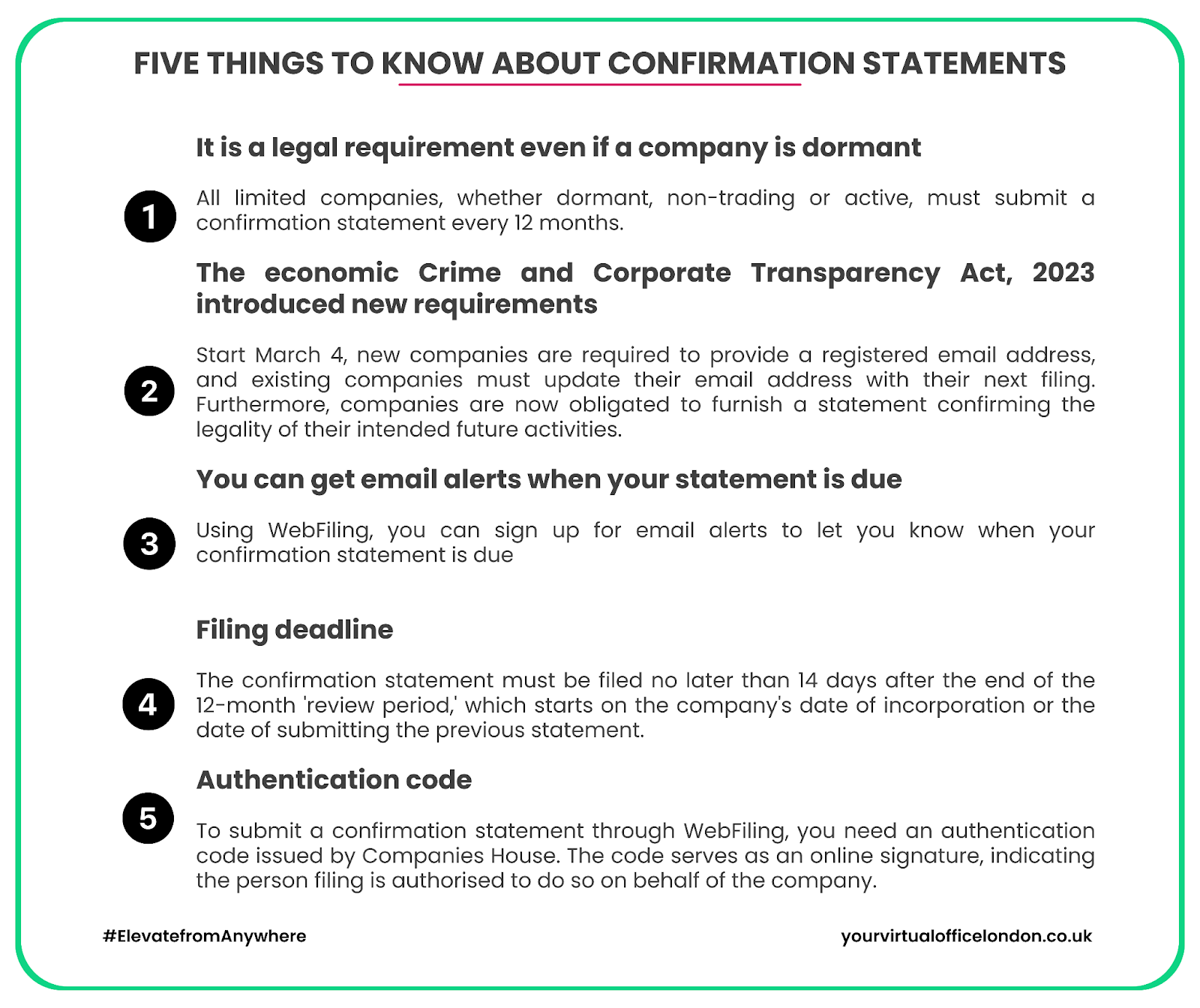What Is a Confirmation Statement?
It is an annual statutory filing requirement for UK private limited companies and LLPs, which verifies that your business particulars held by Companies House are correct at a specific date. You must file at least one confirmation statement at least once a year.
By complying with the requirement, companies uphold transparency and guarantee the accuracy of corporate information within the public domain.
What Information Is Included in a Confirmation Statement?
Before submitting your confirmation statement, search for your company in the public register to review the information Companies House has on record for your company.
Examine it and identify any incorrect or out of date info.

Based on what you find, prepare and submit your confirmation statement to “confirm” the accuracy of your company details or make any required amendments.
The company data to assess in the register which is what you’ll be confirming as accurate in your statement includes —

How to File Your Confirmation Statement With Companies House Online and Make Changes to Your Company Information
To hand in your confirmation statement and update your company details online with Companies House every 12 months, follow these steps:
Please note that the following changes are reported through other Companies House forms.
- Company name;
- Registered office addresses;
- Constitutions;
- Director or secretary;
- Changes in the address where statutory registers are kept or
- PSCs information.
For a more detailed guide, refer to the comprehensive information provided in this GOV.UK guide.
To file your statement follow the steps below –
If there is any detail that does not reflect a recent filing, you are required to complete the relevant form and ensure that the details are reflected before filing the confirmation statement to Companies House.
Once you confirm everything is correct, click on the ‘confirm’ check box and submit.
When Is My Confirmation Statement Due?
You need to file a confirmation statement within 14 days of every 12 months from the date of incorporation. After the first year, subsequent statements should be filed every 12 months from the last confirmation statement date.
The period between the first statement and the date when the next one is due is, known as the review period. For instance, if your company files a confirmation statement on 30 September 2024. Your next review period starts on 1 October 2024 and ends on 30 September 2025.
Remember, all limited companies and limited liability partnerships, even those with no changes to report, are required to verify their company information is correct and up to date.
FAQs
What steps should I take if my company has been struck off and my business bank account is frozen due to failing to submit a Confirmation Statement?
When a company no longer trades or fails multiple times to comply with legal requirements, Companies House marks it for Compulsory strike-off to remove it from the official register so that it ceases to exist as a distinct business entity.
Before starting the strike-off process, Companies House typically issues at least two warning notices. These notices inform directors about the impending strike-off and explain its reasons.
Several factors can lead to an involuntary strike-off, including —
- Failure to file confirmation statements;
- Neglecting to submit accounts;
- All directors resigning or being removed without replacement;
- Failture to inform Companies House about a change of registered address; and
- Ceasing trading without filing for dormancy.
Companies House can commence the compulsory strike-off process if any of the above circumstances arise.
You’ll have at least two months to comply with the requirements mentioned in the warning notice. Seek professional advice or engage Companies House directly to help navigate the situation and explore possible remedies.
Upon receiving a compulsory strike-off notice, address the reasons cited by informing Companies House of your operational status and promptly filing any necessary documents.
After compliance, redirect your attention to addressing frozen accounts by following these steps:
- Settle the winding up petition by clearing any outstanding debt using your private funds.
- Seek a validation order to authorise specific transactions into and out of your bank account during this period.
- Negotiate a Company Voluntary Arrangement (CVA), including a formal repayment plan.
- If necessary, explore the option of closing the company voluntarily through a Creditors’ Voluntary Liquidation (CVL).
These strategic steps can help navigate the complexities associated with a compulsory strike-off, allowing you to address immediate concerns and potentially find a resolution that aligns with your company's circumstances.
How much does it cost to file a confirmation statement?
It costs £34 to file your confirmation statement online via WebFiling, and £62 to send your Companies House form CS01 by post. While this method involves traditional mail, it remains a valid option for those who prefer or require a non-digital submission.
It's crucial to consider the mode of filing that best suits your preferences and circumstances. Online filing is generally faster and may offer real-time confirmation, while postal submissions may take longer due to the manual processing involved. Ensure you factor in these costs and choose the method that aligns with your company's needs and timeline.
See also: How to Use the Companies House WebFiling.
What happens when I forget to file my confirmation statement?
Even if you have a company secretary or accountant, the director is ultimately responsible for meeting company filing requirements, like confirmation statements. If you miss the filing deadline, there could be consequences such as late filing penalties, legal implications, and potential damage to your company's good standing. It's essential to prioritize these filings to avoid complications and ensure compliance with regulatory obligations. Since you can file as many confirmation statements as you want during a review period, consider filing as soon as a reportable change occurs.

























